仁爱版英语七下 语法总结:方位介词
- 格式:doc
- 大小:32.02 KB
- 文档页数:4

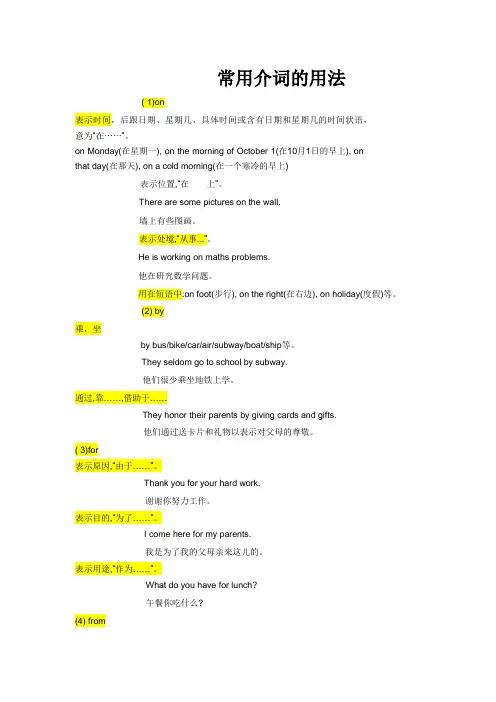
常用介词的用法( 1)on表示时间,后跟日期、星期几、具体时间或含有日期和星期几的时间状语,意为“在······”。
on Monday(在星期一), on the morning of October 1(在10月1日的早上), onthat day(在那天), on a cold morning(在一个寒冷的早上)表示位置,“在······上”。
There are some pictures on the wall.墙上有些图画。
表示处境,“从事...”。
He is working on maths problems.他在研究数学问题。
用在短语中:on foot(步行), on the right(在右边), on holiday(度假)等。
(2) by乘,坐by bus/bike/car/air/subway/boat/ship等。
They seldom go to school by subway.他们很少乘坐地铁上学。
通过,靠……,借助于……They honor their parents by giving cards and gifts.他们通过送卡片和礼物以表示对父母的尊敬。
( 3)for表示原因,“由于……”。
Thank you for your hard work.谢谢你努力工作。
表示目的,“为了……”。
I come here for my parents.我是为了我的父母亲来这儿的。
表示用途,“作为……”。
What do you have for lunch?午餐你吃什么?(4) from自从,来自He is from China.他来自中国。
表示间隔、距离,“离……”。
How far is your school from here?你学校离这儿有多远?用在短语中:be different from(与······不同), from ···to···(从······到……), come from(来自)等。

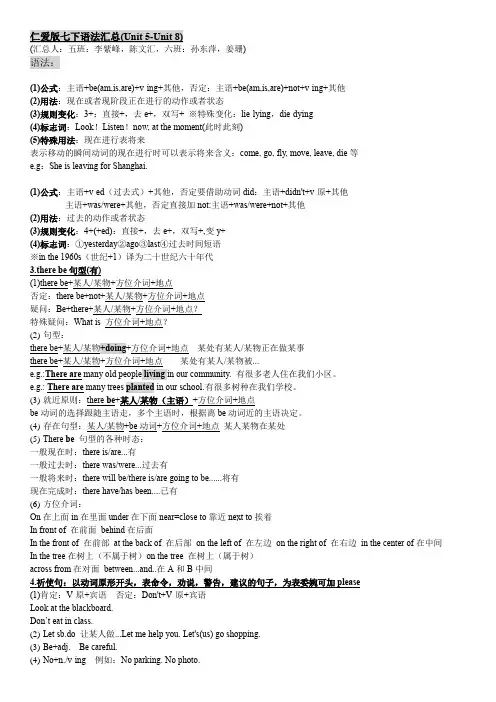
)语法:(1)公式:主语+be(am,is,are)+v-ing+其他,否定:主语+be(am,is,are)+not+v-ing+其他(2)用法:现在或者现阶段正在进行的动作或者状态(3)规则变化:3+:直接+,去e+,双写+ ※特殊变化:lie-lying,die-dying(4)标志词:Look!Listen!now, at the moment(此时此刻)(5)特殊用法:现在进行表将来表示移动的瞬间动词的现在进行时可以表示将来含义:come, go, fly, move, leave, die等e.g:She is leaving for Shanghai.(1)公式:主语+v-ed(过去式)+其他,否定要借助动词did:主语+didn't+v-原+其他主语+was/were+其他,否定直接加not:主语+was/were+not+其他(2)用法:过去的动作或者状态(3)规则变化:4+(+ed):直接+,去e+,双写+,变y+(4)标志词:①yesterday②ago③last④过去时间短语※in the 1960s(世纪+1)译为二十世纪六十年代3.there be句型(有)(1)there be+某人/某物+方位介词+地点否定:there be+not+某人/某物+方位介词+地点疑问:Be+there+某人/某物+方位介词+地点?特殊疑问:What is 方位介词+地点?(2)句型:there be++方位介词+地点某处有某人/某物正在做某事there be+某人/某物+方位介词+地点某处有某人/某物被...e.g.:There are many old people living in our community. 有很多老人住在我们小区。
e.g.: There are many trees planted in our school.有很多树种在我们学校。
(3)就近原则:there be+某人/某物(主语)+方位介词+地点be动词的选择跟随主语走,多个主语时,根据离be动词近的主语决定。

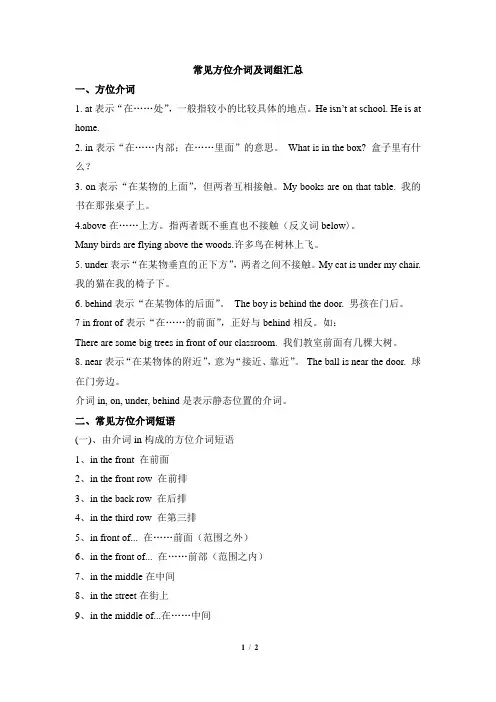
常见方位介词及词组汇总一、方位介词1. at表示“在……处”,一般指较小的比较具体的地点。
He isn’t at school. He is at home.2. in表示“在……内部;在……里面”的意思。
What is in the box? 盒子里有什么?3. on表示“在某物的上面”,但两者互相接触。
My books are on that table. 我的书在那张桌子上。
4.above在……上方。
指两者既不垂直也不接触(反义词below)。
Many birds are flying above the woods.许多鸟在树林上飞。
5. under表示“在某物垂直的正下方”,两者之间不接触。
My cat is under my chair. 我的猫在我的椅子下。
6. behind表示“在某物体的后面”。
The boy is behind the door. 男孩在门后。
7 in front of表示“在……的前面”,正好与behind相反。
如:There are some big trees in front of our classroom. 我们教室前面有几棵大树。
8. near表示“在某物体的附近”,意为“接近、靠近”。
The ball is near the door. 球在门旁边。
介词in, on, under, behind是表示静态位置的介词。
二、常见方位介词短语(一)、由介词in构成的方位介词短语1、in the front 在前面2、in the front row 在前排3、in the back row 在后排4、in the third row 在第三排5、in front of... 在……前面(范围之外)6、in the front of... 在……前部(范围之内)7、in the middle在中间8、in the street在街上9、in the middle of...在……中间10、in the tree在树上(指飞鸟等外来物)(二)、由介词at构成的方位介词短语1、at the front of...在……所在范围的前一部分2、at the back of...在……所在范围的后一部分3、at the foot of...在……脚下4、at the top of...在……顶部5、at the end of...在……尽头6、at the head of...在……前头7、at the (school) gate在(校)门口8、at the station 在车站9、at No.2 Chang’an Road在长安路2号10、at my uncle’s 在我叔叔家11、at home在家12、at the doctor’s在医务室/在诊所(三)、由介词on构成的方位介词短语1、on the right/left在右(左)边2、on one’s right/left在某人的右(左)边3、on the desk/table在课桌/桌上4、on the right-hand/left-hand side在右/左手边5、on the blackboard在黑板上6、on/in the wall在墙上/里7、on the paper在纸上8、on the tree在树上(指树上长的,结的东西)三、其它介词构成的方位介词短语1、next to靠近/贴近2、beside the desk在课桌旁3、behind the door在门后4、under the bed在床下5、near the window靠近窗户6、outside the gate在门外。
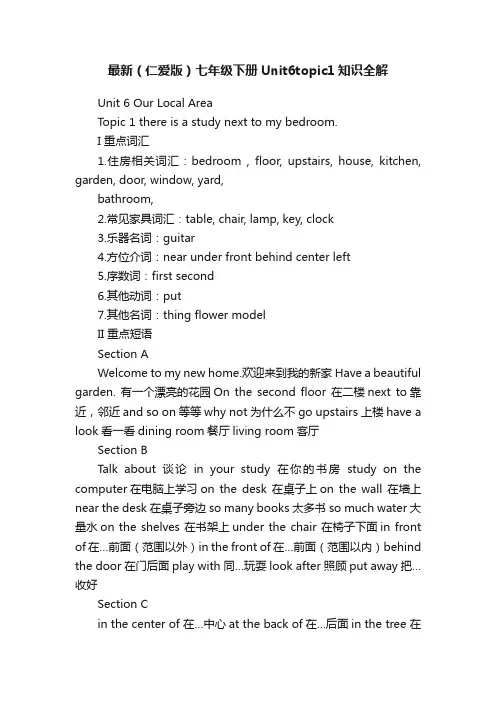
最新(仁爱版)七年级下册Unit6topic1知识全解Unit 6 Our Local AreaTopic 1 there is a study next to my bedroom.I 重点词汇1.住房相关词汇:bedroom , floor, upstairs, house, kitchen, garden, door, window, yard,bathroom,2.常见家具词汇:table, chair, lamp, key, clock3.乐器名词:guitar4.方位介词:near under front behind center left5.序数词:first second6.其他动词:put7.其他名词:thing flower modelII 重点短语Section AWelcome to my new home.欢迎来到我的新家Have a beautiful garden. 有一个漂亮的花园On the second floor 在二楼next to靠近,邻近and so on等等why not为什么不go upstairs 上楼have a look看一看dining room餐厅living room客厅Section BTalk about 谈论in your study在你的书房study on the computer在电脑上学习on the desk 在桌子上on the wall 在墙上near the desk在桌子旁边so many books太多书so much water 大量水on the shelves 在书架上under the chair 在椅子下面in front of在…前面(范围以外)in the front of 在…前面(范围以内)behind the door 在门后面play with 同…玩耍look after 照顾put away把…收好Section Cin the center of 在…中心at the back of在…后面in the tree 在树上on the left of 在…左边on the right of 在…右边help sb. do sth.帮助某人做某事Play on the computer 在玩电脑sing in the tree在树上唱歌clean the study 打扫书房cook in the kitchen在厨房做饭III 语言点1. Welcome to my new home.【home作n.】(对比【home 作adv.】)2. Why not go upstairs and have a look?(1) why not +v动词原形? “何不… …”用于向对方提出建议。
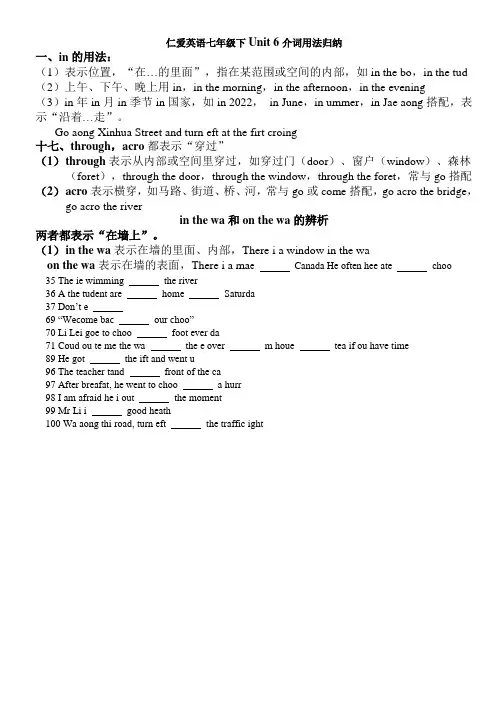
仁爱英语七年级下Unit 6介词用法归纳一、in的用法:(1)表示位置,“在…的里面”,指在某范围或空间的内部,如in the bo,in the tud (2)上午、下午、晚上用in,in the morning,in the afternoon,in the evening(3)in年in月in季节in国家,如in 2022,in June,in ummer,in Jae aong搭配,表示“沿着…走”。
Go aong Xinhua Street and turn eft at the firt croing十七、through,acro都表示“穿过”(1)t hrough表示从内部或空间里穿过,如穿过门(door)、窗户(window)、森林(foret),through the door,through the window,through the foret,常与go搭配(2)a cro表示横穿,如马路、街道、桥、河,常与go或come搭配,go acro the bridge,go acro the riverin the wa和on the wa的辨析两者都表示“在墙上”。
(1)i n the wa表示在墙的里面、内部,There i a window in the waon the wa表示在墙的表面,There i a ma e Canada He often hee ate choo35 The ie wimming the river36 A the tudent are home Saturda37 Don’t e69 “Wecome bac our choo”70 Li Lei goe to choo foot ever da71 Coud ou te me the wa the e over m houe tea if ou have time89 He got the ift and went u96 The teacher tand front of the ca97 After breafat, he went to choo a hurr98 I am afraid he i out the moment99 Mr Li i good heath100 Wa aong thi road, turn eft the traffic ight【试题答案】1 at; in2 b; with3 for; on4 on; of5 on; on6 on7 in 8 in 9 at; ie 10 at; of 11 on; at 12 with; ie13 for 14 of; ie 15 about 16 at; about; in 17 for 18 for19 with 20 near 21 from; with 22 to 23 to 24 in; of 25 of 26 to; on 27 to; at 28 on 29 in 30 from; to31 with 32 for 33 for 34 to 35 in 36 at; on37 to; to 38 of 39 at 40 for 41 in 42 at; on43 with 44 in 45 to 46 in; of 47 off 48 awa; after49 on 50 of; in 51 for 52 in 53 on 54 on55 on 56 on 57 about 58 to; from; in 59 In; at 60 to; in 61 into 62 on 63 to; after 64 at; about 65 with 66 of67 in 68 of; from 69 to 70 on 71 to 72 at73 of; on 74 at 75 at; of 76 to 77 for 78 in79 down / aong; on 80 from; to 81 in; of 82 in 83 ie; in84 of 85 to 86 with 87 with 88 to; for 89 into; to90 for 91 on 92 on 93 on 94 in; of 95 at96 in 97 in 98 at 99 in 100 at。
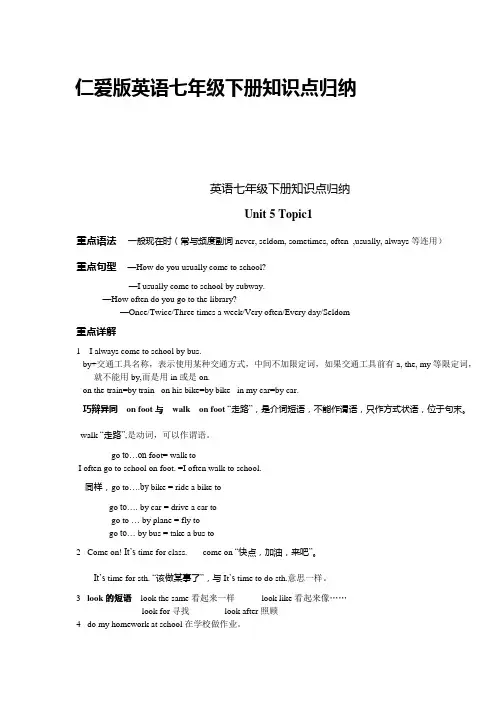
仁爱版英语七年级下册知识点归纳英语七年级下册知识点归纳Unit 5 Topic1重点语法一般现在时(常与频度副词never, seldom, sometimes, often ,usually, always等连用)重点句型—How do you usually come to school?—I usually come to school by subway.—How often do you go to the library?—Once/Twice/Three times a week/Very often/Every day/Seldom重点详解1I always come to school by bus.by+交通工具名称,表示使用某种交通方式,中间不加限定词,如果交通工具前有a, the, my 等限定词,就不能用by,而是用in或是on.on the train=by train on his bike=by bike in my car=by car.巧辩异同on foot 与walk on foot “走路”,是介词短语,不能作谓语,只作方式状语,位于句末。
walk “走路”,是动词,可以作谓语。
go to…on foot= walk toI often go to school on foot. =I often walk to school.同样,go to….by bike = ride a bike togo to…. by car = drive a car togo to … by plane = fly togo to… by bus = take a bus to2 Come on! It’s time for class. come on “快点,加油,来吧”。
It’s time for sth. “该做某事了”,与 It’s time to do sth.意思一样。
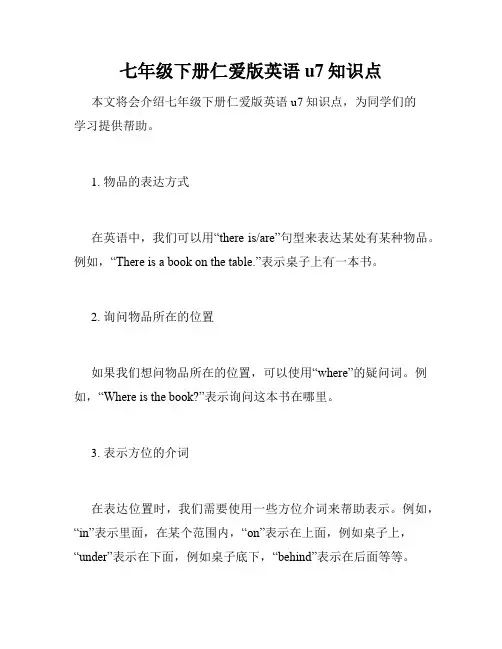
七年级下册仁爱版英语u7知识点本文将会介绍七年级下册仁爱版英语u7知识点,为同学们的学习提供帮助。
1. 物品的表达方式在英语中,我们可以用“there is/are”句型来表达某处有某种物品。
例如,“There is a book on the table.”表示桌子上有一本书。
2. 询问物品所在的位置如果我们想问物品所在的位置,可以使用“where”的疑问词。
例如,“Where is the book?”表示询问这本书在哪里。
3. 表示方位的介词在表达位置时,我们需要使用一些方位介词来帮助表示。
例如,“in”表示里面,在某个范围内,“on”表示在上面,例如桌子上,“under”表示在下面,例如桌子底下,“behind”表示在后面等等。
4. 复数名词的表达方式在英语中,复数名词通常会在末尾加上“-s”。
例如,“book”变成“books”,“pen”变成“pens”。
但也有例外,如“man”变成“men”。
5. 物品的形状与颜色当我们描述物品的时候,还需要注意它的形状和颜色。
例如,“The square table is brown.”表示正方形的桌子是棕色的。
6. 人物相关的表达方式在英语中,用“he”、“she”、“they”来代替男性、女性和复数的人物角色。
例如,“She is my friend.”表示她是我的朋友。
7. 简单的日常对话对话是英语的重要组成部分。
学习者可以进行一些简单的日常对话练习,例如:A: Can you show me the way to the library?B: Sure, it's on the second floor of the main building.A: Thank you very much.B: You're welcome.通过以上介绍,相信同学们对于七年级下册仁爱版英语u7知识点有了更加深入的了解。
希望大家在学习过程中能够勇敢尝试和实践,积极提高自己的英语水平。

about prep.关于,对于beangryat/aboutsth. 对某事生气beexcitedabout/atsth. 对某事感到兴奋/激动besureabout/ofsth. 确信,对某事有把握beworriedabout 对……感到担心comeabout发生talk about谈论,议论tell sb. about sth. 告诉某人某事think about想,考虑(尤指考虑计划、意见、行动等是否可行)warn sb. about/of sth.警告/提醒某人某事worry about担心,烦恼What/How about …?……怎么样?(用来询问或提出建议,后面接代词、名词或具有名词性质的词,如动名词。
)above prep.在……上面(表示位置、职位等);在……以上(表示数量、年龄等)be above不易受到……;不屑于, 超出……之外across prep.横过,穿过;在……的另一边cut across抄近穿过;与……相反after prep. 在……之后;在……后面day after day 一天又一天look after照看,照顾thedayaftertomorrow 后天(经常用于将来时)namesb./sth.aftersb.以……命名;给……取名against prep.对着;反对;靠着playagainst同……比赛along prep.沿着,顺着get along 沿着……走get along/on (well) with sb.与某人相处(融洽)among prep. 在……中间,在(三个以上)之间[注意:between一般指“在两者之中”;among一般指“在三者(或三者以上)之中”]among other things除了别的以外,此外count among把……算作一个;认为……around prep.在……周围;绕过;在……各处,在……附近;大约run around环绕as prep.作为,当作as for 至于,就……方面说as form 从……时起as if 好像,仿佛as of 从……时起as thouth = as if/to 至于,关于be known as作为……而著称;把……叫做be used as (被)用作……(强调被当做工具或手段来用) [be used for (被)用来……(强调用途或作用)be used to do (被)用来去做……(强调目的) be used by 被……使用,by后跟人或物(强调使用者)] design … as …把……设计成……regard … as …把……看作……such as例如,诸如……之类的As the saying goes,“You are what you wear .”正如俗语所讲:“衣如其人。
仁爱版英语七年级下册介词表以下是仁爱版英语七年级下册的介词表。
这些介词将帮助学生准确使用介词以及理解其在句子中的用法。
1. 基本介词(Basic Prepositions)- at(在...(某一地方))- in(在...(某一地方、方位))- on(在...(某一表面))- to(到...(某一地方))- of(属于,关于)- for(为了)- with(和...一起)- by(通过,由于)- from(从...来)- about(关于)2. 时间介词(Time Prepositions)- before(在...之前)- after(在...之后)- during(在...期间)- on(在...日子,星期几)- at(在...时间点)- in(在...时间段)- from...to(从...到...)3. 方位介词(Place Prepositions)- in(在...(内部))- on(在...(表面))- at(在...(位置))- under(在...下面)- over(在...上面)- beside(在...旁边)- between(在...之间)4. 方式介词(Manner Prepositions)- with(用)- by(乘坐,通过)- like(像)- as(作为)5. 成分介词(Part Prepositions)- of(...的一部分)- with(用...,带有...)- as(作为一种)- on(取决于...)- in(通过...方式)以上是仁爱版英语七年级下册的介词表。
学生们可以参考这张表格来研究和运用介词,以提升英语表达能力。
请注意,在实际应用中,介词的用法还需根据具体语境进行调整和运用。
*注意:本介词表参考仁爱版英语七年级下册教材编写,仅供参考,具体用法请以教材为准。
*。
七年级下册仁爱版英语介词知识点英语介词是非常重要的语法知识点。
介词不仅可以改变一个句子的意义,而且也可以让我们的句子更加清晰、精确和流畅。
在七年级下册仁爱版英语教材中,我们学习了很多的介词,下面就让我们一起来回顾一下这些介词的用法和注意点。
一、介词的定义介词是一种连接词,通常用来指出一个名词、代词或动词与其他词之间的关系。
介词一般放在名词、代词或动词之前,表示时间、地点、原因、目的、方式、比较、从属等关系。
二、介词的种类1. 时间介词时间介词用于表示时间的具体概念,例如 on、at、in 等。
举例:On Monday(在星期一)At 7:00(在七点钟)In April(在四月)2. 地点介词地点介词用于表示位置和方向,例如in、on、at、under、over、by、beside、behind 等。
举例:In the classroom(在教室里)On the desk(在桌子上)At the bus stop(在公交车站)Under the tree(在树下面)Over the river(在河上方)By the lake(在湖边)Beside the garden(在花园旁边)Behind the building(在建筑物后面)3. 方式介词方式介词用于表示动作进行的方式和方法,例如 with、by、like 等。
举例:Eat with chopsticks(用筷子吃)Write by hand(手写)Speak like a native(像母语者一样说话)4. 原因介词原因介词用于表示某个情况的原因,例如 because of、due to、owing to 等。
举例:Because of the bad weather,the game was canceled(因为天气恶劣,比赛被取消了)Due to his illness,he couldn't go to school(因为生病了,他不能去上学了)Owing to the heavy traffic,I was late(因为交通拥挤,我迟到了)5. 目的介词目的介词用于表示某个行为的目的或用途,例如 for、to 等。
七年级下册方位介词知识点方位介词是英语中用来描述物体在空间中的位置关系的一种词汇。
在日常生活中,方位介词经常被使用,并且在英语学习中也是非常重要的一部分。
在七年级下册中,掌握方位介词的知识点,将有助于学生更好地理解这一部分内容。
下面将介绍一些七年级下册方位介词的知识点。
1. 在/在…的上面“On”是一个表示物体在另一个物体上方的方位介词,例如:- The picture is on the wall.(图片在墙上。
)- The cat is on the chair.(猫在椅子上。
)其中,“on”也可以用来表示时间上在某个具体日子或在某个时候:- We’ll have the meeting on Tuesday.(我们将在星期二开会。
)2. 在/在…的下面“Under”是一个表示物体在另一个物体下方的方位介词,例如:- The cat is under the table.(猫在桌子下面。
)- The book is under the bed.(书在床下。
)3. 在/在…的前面“in front of”是一个表示一物体在另一个物体前面的方位介词,例如:- The teacher is standing in front of the class.(老师站在课堂前面。
)- The car parked in front of the house.(汽车停在房子前面。
)其中,“in front of”有时也可以被缩写为“in front”或者“front”。
4. 在/在…的后面“behind”是一个表示一个物体在另一个物体后面的方位介词,例如:- The cat is behind the sofa.(猫在沙发后面。
)- The car parked behind the building.(汽车停在建筑物后面。
)5. 在…中间“between”是一个表示两个物体之间的方位介词,例如:- There is a book between the two bottles.(两个瓶子之间有一本书。
七年级仁爱英语语法知识点作为英语学习的初级阶段,七年级学生需要了解一些基础的语法知识点,才能打下坚实的英语学习基础。
本篇文章将介绍七年级仁爱英语语法知识点,帮助学生们更好地掌握语言规则。
一、介词1. 介词的概念介词是表示方位、时间、方式、原因、条件等概念的一类词,如 in、on、among、between 等。
2. 介词的用法介词的常见用法有:a. 表示时间:at、in、on。
如:at six o'clock、 in the morning、on Sunday。
b. 表示空间位置:in、on、at、under、over、beside、between、among 等。
如: in the room、on the table、at the door、under the chair、over the bridge、beside the tree、between the two houses、among the students。
c. 表示原因:because of、due to、owing to 等。
如:due to the bad weather、because of the traffic jam、owing to the delay of the flight。
二、形容词1. 形容词的概念形容词是用来表示人或事物的性质、特征或状态等的词语,如beautiful、happy、tall 等。
2. 形容词的用法形容词的常见用法有:a. 修饰名词:如big book、happy girl。
b. 作表语:如I'm hungry、She is tall。
c. 修饰不定代词:如some nice cars、any interesting films。
三、不定代词1. 不定代词的概念不定代词是指代一个不确定或不具体的人或事物的词语,如some、any、no、every 等。
2. 不定代词的用法不定代词的常见用法有:a. 修饰名词:如some books、any questions。
语法总结:方位介词表示地点的介词in、on、behind、next to、near、over、under(1). in在……里面:The pencil is in the desk. 铅笔在课桌里。
(2). on在……上面:There are some apple on the tree. 树上有些苹果。
(3). under在……下面/正下方:What's under your desk? 你书桌底下是什么?(4). over在……正上方:There is a shelf over the table. 桌子上方有一个书架。
(5). above 在……斜上方:Raise your arms above your head.(6). below 在……斜下方:Her skirt came below her knees.(7).behind在……之后:There is a bike behind the tree. 树后有一辆自行车。
(8).next to在……旁边:There is a café next to the barber's. 理发店隔壁是一家咖啡馆。
(9).near在……附近:My bed is near the window. 我的床在窗户旁。
(10).by 在……旁:He was sitting by the window.第一组:over, above和on的用法1)over指在…的正上方,表示垂直在上。
如:There is a lamp over the desk.2)above指在上方,属于斜上方。
如:Raise your arms above your head.3)on指在上面,表示两物体接触。
如:There is a cup on the table.第二组:under / below的用法:1) under在……下面/正下方:What's under your desk?2) below 在……斜下方:Her skirt came below her knees.练习:( ) 1 The boat is passing___ the bridge.A. throughB. belowC. underD. across( ) 2 Two planes are flying___ the city.A. throughB. overC. on D, below( ) 3 We can see a river running to the east____ the hill.A. underB. belowC. overD. on( ) 4 Do you see the kite ___ the building.A. overB. crossC. onD. above参考答案C B B D第三组:in 和on表示“在……上”门一类——镶嵌在墙里的,用in字画一类——挂在墙面上的,用on( ) 1 He put up a map ___ the back wall because there was a hole ___ it. A. on; on B. at; in C. on; in D. on; at( ) 2 There is a door___ the wall.A. onB. toC. ofD. in( ) 3 Any man ___ eyes______ his head can see that he's exactly like a rope.A. with; onB. with; inC. on; withD. in; with鸟一类落在树上的,用in;苹果一类长在树上的,用on( ) 1 There are some birds singing___ the trees.A. inB. onC. atD. from( ) 2 There are so many apples___ that tree.A. in B, on C. at D. from第四组:in /on/ to表示“接壤”第四组:in /on/ to表示“接壤”B A B AB 在A里——用in A和B相邻(接壤)——用on。
语法总结:方位介词
表示地点的介词in、on、behind、next to、near、over、under
(1). in在……里面:The pencil is in the desk. 铅笔在课桌里。
(2). on在……上面:There are some apple on the tree. 树上有些苹果。
(3). under在……下面/正下方:What's under your desk? 你书桌底下是什么?
(4). over在……正上方:There is a shelf over the table. 桌子上方有一个书架。
(5). above 在……斜上方:Raise your arms above your head.
(6). below 在……斜下方:Her skirt came below her knees.
(7).behind在……之后:There is a bike behind the tree. 树后有一辆自行车。
(8).next to在……旁边:There is a café next to the barber's. 理发店隔壁是一家咖啡馆。
(9).near在……附近:My bed is near the window. 我的床在窗户旁。
(10).by 在……旁:He was sitting by the window.
第一组:over, above和on的用法
1)over指在…的正上方,表示垂直在上。
如:
There is a lamp over the desk.
2)above指在上方,属于斜上方。
如:
Raise your arms above your head.
3)on指在上面,表示两物体接触。
如:
There is a cup on the table.
第二组:under / below的用法:
1) under在……下面/正下方:What's under your desk?
2) below 在……斜下方:Her skirt came below her knees.
练习:
( ) 1 The boat is passing___ the bridge.
A. through
B. below
C. under
D. across
( ) 2 Two planes are flying___ the city.
A. through
B. over
C. on D, below
( ) 3 We can see a river running to the east____ the hill.
A. under
B. below
C. over
D. on
( ) 4 Do you see the kite ___ the building.
A. over
B. cross
C. on
D. above
参考答案C B B D
第三组:in 和on表示“在……上”
门一类——镶嵌在墙里的,用in
字画一类——挂在墙面上的,用on
( ) 1 He put up a map ___ the back wall because there was a hole ___ it. A. on; on B. at; in C. on; in D. on; at
( ) 2 There is a door___ the wall.
A. on
B. to
C. of
D. in
( ) 3 Any man ___ eyes______ his head can see that he's exactly like a rope.
A. with; on
B. with; in
C. on; with
D. in; with
鸟一类落在树上的,用in;
苹果一类长在树上的,用on
( ) 1 There are some birds singing___ the trees.
A. in
B. on
C. at
D. from
( ) 2 There are so many apples___ that tree.
A. in B, on C. at D. from
第四组:in /on/ to表示“接壤”
第四组:in /on/ to表示“接壤”
B A B A
B 在A里——用in A和B相邻(接壤)——用on
A B
A和B不相邻(不接壤)——用to
练习
( ) 1 The United States is ____ the south of Canada and ___ the east of Japan.
A. to; in
B. on; to
C. in; beside
D. at; on
( ) 2 The man stood ____the window, watching the boys playing outside. A. in B. by C. with D. to
( ) 3 Japan lies____ the east of China.
A. on B/ to C. in D. with
参考答案B B B B
第五组:at, in表示“在……”
1)at表示较小的地点。
如:at the bus stop, at home
2)in表示较大的地点。
如:in China, in the world
( ) 1 Uncle Wang arrived____ No. 14 Middle School half an hour ago. A. at B. in C to D. /
( ) 2 My uncle lives ____ 88 Beijing Street.
A. to
B. of
C. at
D. on
( ) 3 They are waiting ___ a bus ___ the bus stop.
A. for; in
B. on; at
C. with; at
D. for; at
第六组:in front of 和in the front of
1)in front of表示“在…之前”(范围外)。
如:There are some trees in front of the classroom.
2)in the front of 表示“在…的前部”(范围内)
如:There is a blackboard in the front of the classroom.
第七组:in / into
in表示“在……里面”,强调静态;
into表示“去……里面”,强调动态。
第八组:through / across通过,穿过
across表示横过,即从物体表面通过,与on有关,为二维through穿过,即从物体内部穿过,与in有关,为三维。
( ) 1 Is the street too narrow for the bus to go ___?
A. through
B. across
C. on
D. in
( ) 2 A mother camel was walking ___ her son ___ the desert.
A. without; along
B. with; through
C. next to; pass
D. beside; through
( ) 3 The river runs____ the city.
A. across
B. through
C. over
D. from
( ) 4 It took us over an hour to walk____ this street.
A. from
B. through
C. over
D. across
参考答案A B B B。